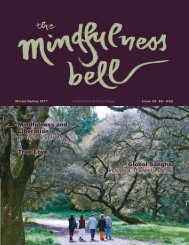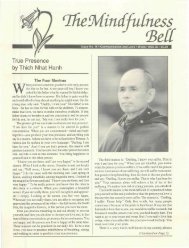View full issue in PDF - The Mindfulness Bell
View full issue in PDF - The Mindfulness Bell
View full issue in PDF - The Mindfulness Bell
You also want an ePaper? Increase the reach of your titles
YUMPU automatically turns print PDFs into web optimized ePapers that Google loves.
One of the veterans <strong>in</strong> our writ<strong>in</strong>g group, Mike Wong,<br />
was a deserter dur<strong>in</strong>g the war <strong>in</strong> Vietnam. He went to<br />
Canada and met American, Canadian, and Vietnamese draft<br />
resisters and evaders. Mike wrote a wonderful scene about a<br />
peace demonstration with his friends that turned <strong>in</strong>to a sit-<strong>in</strong><br />
<strong>in</strong> the middle of the street. <strong>The</strong>se young men were risk<strong>in</strong>g<br />
deportation, arrest, and be<strong>in</strong>g put back <strong>in</strong> the army and<br />
shipped to Vietnam, but they sat <strong>in</strong> the middle of the street<br />
anyway. Suddenly, there was a moment of peace as the<br />
crowds went around them. In writ<strong>in</strong>g that scene, Mike<br />
described everyth<strong>in</strong>g- the feel of the concrete street they<br />
were sitt<strong>in</strong>g on, the noise of the crowd, the excitement of the<br />
mounted policemen on their horses, the people shout<strong>in</strong>g,<br />
"Take the street!" He wrote about the peacefulness and the<br />
great joy of th<strong>in</strong>gs not happen<strong>in</strong>g-they were not arrested,<br />
they were not run down, they were not beaten up by the<br />
police- much like Thich Nhat Hanh's rem<strong>in</strong>der to appreciate<br />
a non-toothache. Mike had the ability to show a great<br />
moment of peace right <strong>in</strong> the middle of violence and fear.<br />
Many psychotherapists have believed that people need to<br />
go deeply <strong>in</strong>to their traumas and wounds and talk about<br />
them. But lately, there has been some thought that it might<br />
be better to strengthen the positive, joyful aspects of life. I<br />
learned about this <strong>in</strong> my hometown of Stockton, California.<br />
Several years ago, a man came <strong>in</strong>to a schoolyard with a<br />
mach<strong>in</strong>e gun and killed many Southeast Asian children.<br />
Afterward, therapists from all over the state came to help the<br />
children. <strong>The</strong> therapists wanted the children to talk about the<br />
man with the gun, about who was killed next to them, and<br />
so on. But the Vietnamese community <strong>in</strong> Stockton said they<br />
had their own way of handl<strong>in</strong>g it. <strong>The</strong>y had Sangha meet<strong>in</strong>gs,<br />
meditations, tea ceremonies, and games. <strong>The</strong>y constantly<br />
had joyful practices with the children.<br />
Last Thanksgiv<strong>in</strong>g at Plum Village, Thich Nhat Hanh<br />
said to several of us, "Let go of your suffer<strong>in</strong>g. Don't be<br />
attached to the suffer<strong>in</strong>g." But we also remembered him<br />
say<strong>in</strong>g at another time, "Stick to your suffer<strong>in</strong>g." I have<br />
come to the conclusion that there is no contradiction <strong>in</strong> these<br />
statements. In our writ<strong>in</strong>g and <strong>in</strong> our contemplation, we do<br />
both. <strong>The</strong>re are times when we attach to our suffer<strong>in</strong>g, we<br />
feel it, we contemplate it, we breathe it, we hold it, we write<br />
about it, and we f<strong>in</strong>d words for it. We almost <strong>in</strong>st<strong>in</strong>ctively<br />
do that. But the idea of lett<strong>in</strong>g go of suffer<strong>in</strong>g is a really new<br />
thought. Instead of com<strong>in</strong>g directly at that suffer<strong>in</strong>g, we can<br />
contemplate our joy. When we do this, peace and joy<br />
become solid and strong and suffer<strong>in</strong>g takes care of itself.<br />
Human joy is an advanced stage of our evolution.<br />
Max<strong>in</strong>e Hong K<strong>in</strong>gston, w<strong>in</strong>ner of the National Book<br />
Award, is author of <strong>The</strong> Woman Warrior, Ch<strong>in</strong>a Men,<br />
Hawaii One Summer, and Tripmaster Monkey. She leads<br />
meditation and writ<strong>in</strong>g workshops for veterans of war.<br />
Redwood Sangha<br />
by Wendy Johnson<br />
M<br />
any years ago Thich Nhat Hanh walked through the<br />
filtered light of the redwood trees <strong>in</strong> Muir Woods<br />
National Monument and rem<strong>in</strong>ded us that West Coast<br />
Dharma students were practic<strong>in</strong>g <strong>in</strong> the protection of a true<br />
"Redwood Sangha." Just as the stately sugar maple of<br />
eastern Canada gives color and form to Maple Village<br />
'Sangha on the outskirts of Montreal, and the gnarly,<br />
drought-hardy manzanita def<strong>in</strong>es the l<strong>in</strong>es of Manzanita<br />
Village <strong>in</strong> the Anza-Borrego wilderness of Southern<br />
California, so does the old growth redwood of the Pacific<br />
Northwest susta<strong>in</strong> and deepen the Dharma practice of those<br />
of us liv<strong>in</strong>g <strong>in</strong> the remnants of the Redwood Empire.<br />
This empire once stretched <strong>in</strong> a vast, 2000-mile arc from<br />
Icy Strait on the North Alaskan panhandle as far south as the<br />
forested flanks of Monterey Bay <strong>in</strong> central California. When<br />
Europeans first entered these forests <strong>in</strong> the 1700s, they<br />
walked <strong>in</strong>to woods that had grown undisturbed for millennia.<br />
<strong>The</strong> dom<strong>in</strong>ant conifers of these forests- western<br />
hemlock, Sitka spruce, noble fir, western red cedar, Douglas<br />
fir, Port Orford cedar, and coastal redwood- are all ancient<br />
trees, some grow<strong>in</strong>g to a height of 200-300 feet. By a<br />
million and a half years ago, these conifers had established<br />
their dom<strong>in</strong>ance on the temperate Pacific Slope where they<br />
have grown undisturbed s<strong>in</strong>ce the dawn of time.<br />
In the 1870s, commercial West Coast logg<strong>in</strong>g began <strong>in</strong><br />
earnest and these forests came under the saw blade of a<br />
boom<strong>in</strong>g timber <strong>in</strong>dustry . Now, only a scant four percent of<br />
the orig<strong>in</strong>al two million acres of old growth redwood<br />
rema<strong>in</strong>s. Loss of this ancient forest signals loss of life and<br />
habitat for numerous <strong>in</strong>habitants of the forest <strong>in</strong>clud<strong>in</strong>g<br />
microscopic mycorrhizal fungi, the endangered Pacific giant<br />
salamander, the coho salmon, the California black bear, the<br />
red tree vole, the northern spotted owl and the elusive,<br />
threatened marbled murralet.<br />
Old growth redwoods have been my home and my<br />
teacher for 25 years. Every w<strong>in</strong>ter at Green Gulch Farm we<br />
dedicate January and February to car<strong>in</strong>g for these trees and<br />
plants. Each February s<strong>in</strong>ce 1987, we have a Family Day of<br />
M<strong>in</strong>dfulness dur<strong>in</strong>g which we plant and tend seedl<strong>in</strong>g<br />
redwood and Douglas fir trees. Some of our orig<strong>in</strong>al trees<br />
now stand eight feet tall with their long limbs stretched to<br />
the sun. Children who attended our first plant<strong>in</strong>gs come<br />
every year to visit their young Redwood Sangha.<br />
Over the last two years, I have jo<strong>in</strong>ed many people <strong>in</strong><br />
speak<strong>in</strong>g out for the protection of our rema<strong>in</strong><strong>in</strong>g old growth<br />
forests. In partiCUlar, I have been <strong>in</strong>volved <strong>in</strong> the peaceful<br />
and steady campaign to protect the last stand of old growth<br />
redwoods on private land, the 60,000 acre Headwaters forest<br />
owned by Pacific Lumber Company <strong>in</strong> southern Humboldt<br />
County, California. Ten years ago, the company was taken<br />
over by Charles Hurwitz. In order to repay his sizable junk<br />
7
















